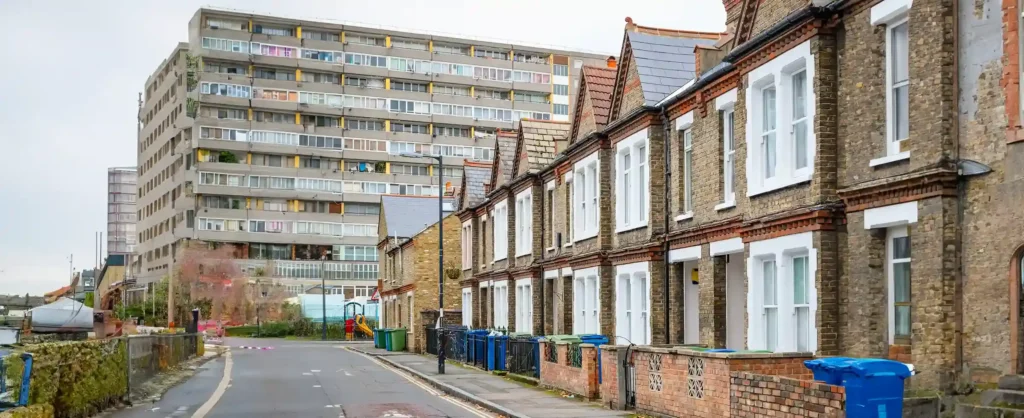Commercial property has long been considered a staple of a modern, industrialised society. Where there are people, businesses and a need for profit there has always been a similar need for workspaces, warehouses and retail stores. The strength of this relationship led to commercial property becoming one of the most significant markets in the world, with the UK market alone valued at $1.7tn in 2022.
Still, recent events and economic shifts have left the future of commercial property uncertain, with many investors feeling as if the area lacks the promise and potential of residential real estate in the investment landscape of tomorrow.
Are you a current or would-be property investor hoping to turn a nest egg into passive income? Here are three reasons why commercial property investment may not be the best solution.
1. The Impact of COVID-19 on Commercial Property Usage
The first risk imposed on investing in the commercial property market is arguably the most significant.
You can plan for many things when you’re a property investor, but a global pandemic is not one of them. COVID-19 may be seen as more or less under control by this point, but its aftershocks are still being felt by the global economy and the people who drive it.
Team CCG’s Ernest Moore already touched upon the impact COVID had on the UK’s homelessness numbers in an opinion piece last month, but a freeze in housing benefits and a subsequent spike in rent hikes are just the tip of the pandemic’s economic iceberg.
With the threat of infection prompting mass self-isolation on a global scale, many companies were forced to rapidly embrace remote working. Though self-isolation has since been relaxed, the benefits of remote working for employers and staff have allowed it to cement itself as a permanent fixture in our everyday professional lives.
This phenomenon is so pronounced in the UK especially that some have dubbed it the “working from home capital of Europe,” with employees spending an average of 1.5 days a week working remotely compared to the international average of 0.9 days. While only 12% of UK employees were remote working before the pandemic in 2019, that number climbed to 25%-40% by 2022, with London residents reporting the highest levels of hybrid working in the country. Moreover, a March 2023 survey LinkedIn survey revealed that more than a third of UK workers would quit their jobs if ordered to return to full-time office work, suggesting that working from home is very much here to stay.
But where does the rapid adoption of remote working leave the commercial property market?
According to data from global real estate service provider Savills, the average occupancy rate for European offices pre-pandemic was 70%. This fell to a recorded 43% in June 2022 and, while February 2023 saw a 12% increase in occupancy, it still falls dramatically shy of peak pre-pandemic numbers while demand for hybridised working continues to climb. Further data from global consultancy firm McKinsey & Company provides further evidence for a decline in commercial property values, with highlights including:
- Global office attendance falling 30% below pre-pandemic levels
- Demand for office space being projected to fall 13%-38% lower in 2030 than in 2019
- London showing one of the highest rates of people leaving core urban areas
- Foot traffic in urban retail areas falling to 36% below pre-pandemic levels
In total, this represents a potential decline in the global value of office space of 24-42% by 2030, representing a catastrophic loss of $800bn and a significant risk for commercial property investors that many are choosing to avoid.
2. The Cost of Building Sustainability into Commercial Property
In 2019, the UK became the first major economy to pass net zero emissions laws requiring it to end its contribution to global warming by 2050. With the revelation that the built environment of the UK is responsible for approximately 40% of carbon emissions and that half of those emissions come from energy usage in buildings and infrastructure, the commercial property sector sits at the centre of net zero efforts.
According to real estate agency Savills UK, the office sector – which accounted for 25% of the global commercial property market in 2022 – saw a fall in transaction volume by almost 50% as many institutional investors left the market in the second half of 2022. A large part of this massive decline in investor interest could be attributed to projections of around 87% of UK office stock being obsolete by 2030 under the proposed Minimum Energy Efficiency Standards (MEES) regulation.
Investor fears around obsolescence risk have led to buildings with top sustainability ratings commanding a 25% price premium in London, but, with a consultancy firm JLL suggesting that more than 1bn square metres of office space will need to be retrofitted at a rate of 3.0-3.5% a year to meet net-zero targets, the costs of retrofitting existing office space for sustainability may be too much for many investors to tackle.
You can read more about the upcoming changes to MEES regulation in our EPC blog.
3. Cold Feet from Banks and Commercial Property Investors
With the dual pressures of an economic downturn and a rising disuse of commercial property across the world, commercial property investors and the banks that finance their projects are increasingly pulling away from the sector.
In addition to the previously mentioned departure of almost 50% of institutional investors from the office sector, office construction is currently suffering the worst decline since the pandemic according to JLL. 1.7m square metres of European completions were postponed in 2022, with a further 12m square metres being postponed in 2023, equating to almost a quarter of expected completions.
With the supply of green, sustainable buildings dwindling alongside these declining construction rates, the commercial property market stands on the brink of an unprecedented supply shortage that will find occupiers struggling to secure adequate office space that meets net-zero targets once existing leases come to an end.
European office investment in the first half of 2023 was also down 62% from the first half of 2022, with the blame falling to rapidly rising and volatile financing costs, post-pandemic structural shifts and uncertain pricing dynamics. Though JLL anticipates that this could change in the coming years, most investors expect negative returns from UK commercial property in 2023.
For their part, banks have also shown an apprehension towards commercial property investment. Global business news agency Reuters recently reported that U.S. banks have been increasing reserves for commercial real estate exposure, citing extreme losses from the sector in the first half of 2023 and anticipating further losses in the near future. With European banks also reporting that demand for loans and mortgages has fallen to the lowest on record, commercial property projects are certain to be treated with increased scrutiny and caution going forward.
Can I Still Invest in Residential Property?
While commercial property is still considered relatively high risk for modern investors, residential property can still be as reliable an investment as ever. Though rising mortgage rates and other economic factors have made traditional buy-to-let riskier for landlords than it has been in the past, investing in mortgage-free buy-to-let property can avoid the dangers of borrowing at a time of inflated interest rates while still netting consistent passive income.
At Concept Capital Group, we specialise in fully managed buy-to-let property investment using a streamlined, sustainable and affordable alternative to traditional property in modular construction.
Our homes are built to exacting standards of quality using the British Standards Institution’s BS3632 specifications for year-round residential living. That means they offer comfort and amenities that rival those of traditional brick-and-mortar homes.
For those seeking to invest in property without having to worry about the stress of management or the uncertainty of the economic climate, our modular homes may be the ideal choice for a less-than-ideal private rented sector.
To find out how you can get involved, book a call with our team today.













